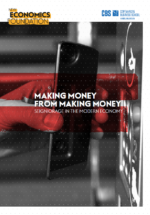£23bn — the hidden annual bonus for Britain’s banks
Banks creaming billions a year from UK taxpayer in 'money for nothing' subsidy
31 January 2017
- Commercial banks control 97% of Britain’s money supply
- HSBC, RBS, Barclays and others enjoy a subsidy of £23bn due to their ability to create new money
- Taxpayers have missed out on £182bn since 1998 by allowing only commercial banks to issue digital money
Analysis from the New Economics Foundation, in collaboration with the Copenhagen Business School, today reveals the huge public subsidy enjoyed by commercial banks through their control of Britain’s money supply.
Only 3% of British money takes the form of physical cash created by the Bank of England. The remaining 97% is electronic bank deposits created by private banks. This privileged position in the UK economy has enabled the likes of HSBC, RBS and Barclays to enjoy a subsidy of £23bn a year since 1998.
The subsidy amounts to 73% of banks’ after-tax and provisions profit — a huge financial advantage unavailable to non-bank businesses, including peer-to-peer lenders and the ‘fin-tech’ sector.
With physical cash declining in proportion to electronic bank money, taxpayers have only a limited stake in this essential public infrastructure. The Bank of England and HM Treasury makes just £1.3bn a year through their issuance of new bank notes.
Had the Bank of England been responsible for issuing just 30% of Britain’s money supply, the public finances would have benefited from £182bn in accrued revenues since 1998 – around 11% of the current public sector net debt.
Huge subsidy for Britain’s biggest banks
The UK banking sector — which is dominated by a small number of giant institutions — enjoy these huge annual subsidies as a result of seigniorage.
This term originally meant the difference between the cost of printing physical cash and its purchasing power. But in modern economies like the UK, 97% of money is now created as digital bank loans rather than cash issued by the state.
Unlike financial intermediaries such as peer-to-peer (P2P) lending platforms, banks do not have to acquire funds before making loans. This is because banks create new money in the process of granting credit, in the form of electronic bank deposits.
Our calculations (see note 2) show seigniorage profits for commercial banks amounted to £23bn per year between 1998 and 2016, equivalent to 1.23% of GDP and a total, cumulative profit of £443bn — a massive ‘money for nothing’ subsidy given less than 10% of British banks’ lending actually supports businesses.
Taking control of Britain’s money
By granting commercial banks monopoly control over the supply of electronic money, the UK government is losing out on billions in potential revenue.
If the Bank of England were to issue digital currency directly, the government could recapture seigniorage revenue for the public purse – as it currently does with banknotes.
If just 30% of Britain’s money supply had been in the form of digital central bank currency instead of commercial bank deposits since 1998, the government would have gained £182bn in seigniorage revenue — a huge boost to public finances.
Josh Ryan-Collins, Senior Economist at the Foundation, said:
“Big banks have too much control over our everyday finances. Their grasp over Britain’s money supply has earned them billions in a hidden, money for nothing subsidy, given the majority of their lending does not support businesses.”
“Money creation is part of our vital public infrastructure. We can’t afford to let banks set the rules and then profit from them. The British state should also have the power to create digital cash, a power that commercial banks have enjoyed for decades.”
Ole Bjerg, Associate Professor at Copenhagen Business School, said:
“Seigniorage is conventionally defined as the profits accrued by the sovereign through the creation of money. Today the lions’ share of seigniorage is accrued by private commercial banks. This fact should make us consider, where sovereignty lies in contemporary society.”
- ENDS -
Notes to editors
- The New Economics Foundation is the UK’s only people-powered think tank. The Foundation works to build a new economy where people really take control.
www.neweconomics.org
- The Foundation’s model for calculating commercial bank seigniorage is determined by the difference between the interest rate that banks pay holders of their IOUs (deposits) and a benchmark market interest rate that non-bank issuers of debt pay on their IOUs.We calculate the value of commercial bank opportunity-cost seigniorage (‘commercial bank seigniorage’) in a given time period as commercial bank money outstanding (deposits) multiplied by the spread between the market rate of interest the bank would have incurred had it been a non-bank and the customer deposit rate the bank offers.
- The Bank of England is actively investigating the potential risks and benefits of introducing Central Bank Digital Currency (CBDC). It is has made it one of its priority research topics — see http://www.bankofengland.co.uk/research/Pages/onebank/cbdc.aspx and written a working paper suggesting it would have major economy wide benefits: http://www.bankofengland.co.uk/research/Documents/workingpapers/2016/swp605.pdf
The Central Bank of Sweden has said it will decide on whether or not to introduce Central Bank Digital Cash within 2 years: http://www.wsj.com/articles/swedens-central-bank-considers-digital-currency-1479296711
- The Foundation’s calculation of the impact of introducing 30% of the money supply in the form of Digital Central Bank Cash assumes that since CBDC would be a liability of the Bank of England, it would need to be balanced on the Bank of England’s balance sheet by equivalent assets.We assume the Bank of England would back the digital cash with UK government bonds which it would purchase on the secondary market, just as it has done through the programme of Quantitative Easing. The Bank of England would therefore generate seigniorage income from interest earned on the government bonds which back the CBDC on the Bank of England’s balance sheet.
As with QE, the interest payments made by the government to the Bank of England would be remitted to HM Treasury, therefore generating significant cash savings for the government.
Topics Banking & finance







